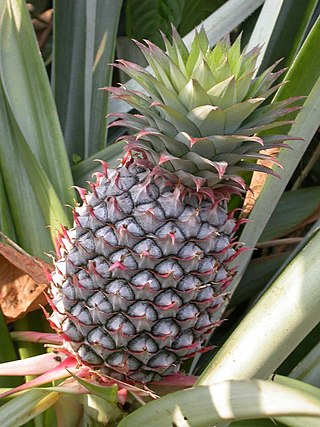
The Bromeliaceae are a family of monocot flowering plants of about 80 genera and 3700 known species, native mainly to the tropical Americas, with several species found in the American subtropics and one in tropical west Africa, Pitcairnia feliciana.
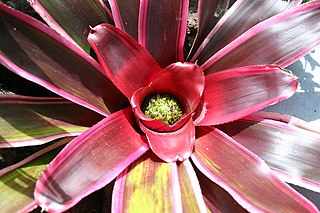
Neoregelia is a genus of epiphytic flowering plants in the family Bromeliaceae, subfamily Bromelioideae, native to South American rainforests. The genus name is for Eduard August von Regel, Director of St. Petersburg Botanic Gardens in Russia (1875–1892).
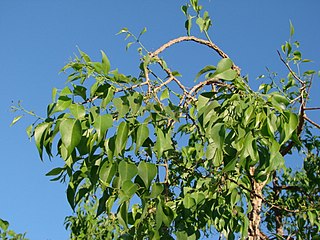
Agonandra is a genus of plants in the family Opiliaceae described as a genus in 1862.
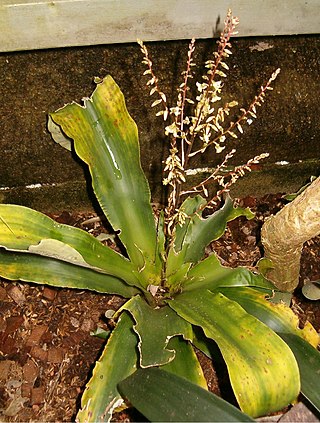
Fosterella is a genus of plants in the family Bromeliaceae, subfamily Pitcairnioideae. It contains 31 recognized species, 30 native to central and western South America, one to Mesoamerica. The genus is named after Mulford B. Foster, American horticulturist and collector (1888-1978).
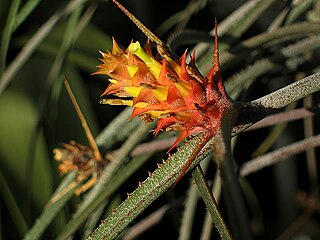
Acanthostachys is a genus of the botanical family Bromeliaceae, subfamily Bromelioideae. The genus name is from the Greek “acanthos” and “stachys”.

Dalechampia dioscoreifolia is a species of plant in the family Euphorbiaceae first described in 1841. It is native to Central America and northern and western South America.

Dyckia is a genus of plants in the family Bromeliaceae, subfamily Pitcairnioideae.

Bromelioideae is a subfamily of the bromeliads (Bromeliaceae). This subfamily is the most diverse, represented by the greatest number of genera with about 40. Most of the plants in this group are epiphytes, though some have evolved in, or will adapt to, terrestrial conditions. This subfamily features the most plant types which are commonly cultivated by people, including the pineapple.

Nidularium is a genus in the plant family Bromeliaceae, subfamily Bromelioideae. Named to describe the nestling characteristic of the inflorescence, all the species are endemic to Brazil. Commonly confused with Neoregelia which they resemble, this plant group was first described in 1854.
Wittmackia bicolor is a species of flowering plant in the family Bromeliaceae, endemic to south Brazil. It was first described by Lyman Bradford Smith in 1955 as Aechmea bicolor.
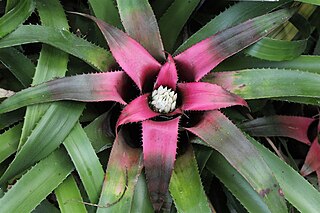
Hylaeaicum is a genus of flowering plant in the family Bromeliaceae, native to tropical northern South America. The taxon was first described by Ernst Heinrich Georg Ule in 1935 as a subgenus of "Aregelia". It was later treated as a subgenus of Neoregelia, before being raised to a full genus in 2021, a status accepted by both Plants of the World Online and the Encyclopaedia of Bromeliads.
Guzmania melinonis is a species of plant in the genus Guzmania. This species is native to Bolivia, Peru, Colombia, the Guianas, Venezuela, Amazonas State of Brazil, and Ecuador.
Hylaeaicum mooreanum is a species of flowering plant in the family Bromeliaceae, native to Ecuador and northern Peru. It was first described by Lyman Bradford Smith in 1962 as Neoregelia mooreana.
Hylaeaicum myrmecophilum is a species of flowering plant in the family Bromeliaceae, native to northern Brazil, Colombia, Ecuador and Venezuela. It was first described by Ernst Heinrich Georg Ule in 1905.
Hylaeaicum pendulum is a species of flowering plant in the family Bromeliaceae, native to Ecuador and northern Peru. It was first described by Lyman Bradford Smith in 1963 as Neoregelia pendula.
Hylaeaicum stoloniferum is a species of flowering plant in the family Bromeliaceae, native to Colombia, Ecuador, Peru and Venezuela. It was first described by Lyman Bradford Smith in 1963 as Neoregelia stolonifera.
Hylaeaicum levianum is a species of flowering plant in the family Bromeliaceae, native to northern Brazil, Colombia and Venezuela. It was first described by Lyman Bradford Smith in 1968 as Neoregelia leviana.
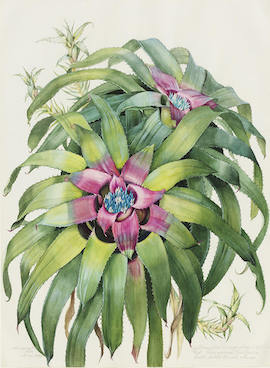
Hylaeaicum margaretae is a species of flowering plant in the family Bromeliaceae, endemic to Brazil. It was first described in 1968 as Neoregelia margaretae. The specific epithet pays homage to Margaret Mee, a British botanical artist who carried out fifteen expeditions to the Amazon rainforest to collect and paint rare or endangered plant species, including many species of Bromeliaceae.
Elton Martinez Carvalho Leme is a Brazilian who is employed as a judge. He is also a self-taught botanist with a special interest in bromeliads. As of November 2022, the International Plant Names Index listed 629 scientific names which include Leme as a publishing author, including 13 generic names.
Hylaeaicum meeanum is a species of flowering plant in the family Bromeliaceae, endemic to Brazil. It was first described in 1975 as Neoregelia meeana. It was first collected by Margaret Mee, near the source of Rio Andirá, near Parintins. It may be treated as a synonym of Hylaeaicum levianum, but as of November 2022 was accepted by Plants of the World Online and the Encyclopaedia of Bromeliads.











